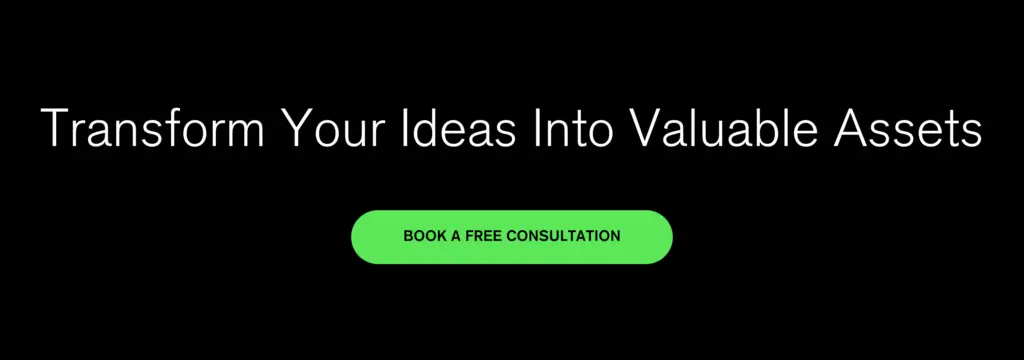Inventing a new product or service is an exciting journey. It’s a process that combines creativity, innovation, and problem-solving. But what happens when your invention patent is still pending?
The patent pending status can be a challenging period for inventors and entrepreneurs. It’s a time of waiting, filled with uncertainty and potential legal complexities.
However, it’s also a time of opportunity.
This guide will explore how to monetize your invention while your patent is pending. It will demystify the patent application process and provide actionable strategies for generating revenue from your invention before the patent is fully granted.
If you have an invention and don’t yet have a patent application filed, we recommending consulting an experienced patent attorney. The patent attorney team at Schell IP in Denver, Colorado is here to help.
Understanding Patent Pending Status
The “patent pending” status is a crucial phase in the patent process. Once you’ve filed a patent application, your invention gains this status. It signifies that a formal patent application is underway but not yet granted.
This label provides a degree of protection. Potential infringers are deterred by the implication of future patent rights. While it doesn’t offer full legal protection, it grants a competitive edge. Patents can take months or years to process, making the pending status significant for market positioning. Knowing its implications helps you strategize monetization efforts during this period.
Filing a Provisional Patent Application
Filing a provisional patent application is a strategic move for inventors. It secures an early filing date, establishing priority without requiring formal patent claims. This approach offers flexibility and is less costly than a non-provisional application. It gives inventors time to refine their inventions before committing to the full patent process.
The benefits of filing a provisional patent include:
- Early filing date – Priority in the patent queue.
- Lower cost – More affordable than a full application.
- Time extension – Up to 12 months to finalize your invention.
This provisional status allows inventors to confidently label their inventions “patent pending.” This offers initial protection while exploring commercial opportunities.
The Power of the “Patent Pending” Label
The “patent pending” label is more than just a status symbol. It serves as a warning to competitors that an invention patent application has been filed. This discourages potential copycats from infringing on your idea, knowing legal protection might be imminent.
Additionally, this label can boost credibility with potential partners and customers. It communicates that you’re serious about protecting your invention. This assurance can make your product more attractive to investors and licensees, providing a competitive advantage during commercialization efforts.
Monetization Strategies During Patent Pending Phase
The patent pending phase offers opportunities to explore diverse monetization strategies for your invention. Although your patent is not yet granted, you can actively pursue revenue streams to begin capitalizing on your work.
Effective strategies to consider include licensing your invention, selling it outright, and engaging in crowdfunding efforts. Also, starting a business based on your invention can create a solid foundation for future growth. Selecting the right path depends on your goals, resources, and market potential.
An experienced patent attorney should be able to help provide guidance on a intellectual property strategy to help you monetize your invention, even while the patent is pending. That way, you can make the right decision for your invention.
Licensing Your Invention
Licensing can be a lucrative option during the patent pending phase. It involves granting permission to another party to manufacture, use, or sell your invention in exchange for royalties. This arrangement allows you to benefit financially without the burden of manufacturing or marketing.
When entering a licensing deal, ensure the terms protect your interests. Key elements to include are:
- Scope of license
- Royalties
- Duration
- Termination conditions
A well-negotiated agreement can provide steady income and free up time for further invention development.
Selling Your Patent Pending Invention
If immediate revenue is your priority, selling your invention outright might be appealing. This strategy involves transferring the patent rights to another entity for a lump sum payment.
Selling can provide the capital needed for other ventures. However, it relinquishes control over the invention’s future use. Consider the market potential and consult a professional to determine a fair value for your invention.
The decision should align with your long-term business strategy. If you do decide to sell, ensure your patent attorney is involved in the deal to help you get the best value for your invention.
Crowdfunding and Market Validation
Crowdfunding offers a dual advantage: raising capital and validating your invention’s market demand. Platforms like Kickstarter and Indiegogo allow you to present your idea to potential backers.
Successful campaigns can generate funds and valuable feedback. This input helps refine your invention and gauge consumer interest. Be transparent about your patent-pending status to build trust with backers. The community support also paves the way for product development and scaling.
Starting a Business Around Your Invention
Entrepreneurs may choose to build a business around their patent pending invention. This approach requires dedication but can yield substantial rewards.
By creating a company, you control the invention’s development, marketing, and sales. This strategy can enhance brand strength and market position. A solid business plan is crucial for attracting investors and partners. It’s vital to ensure the company structure aligns with the commercialization goals, offering a scalable path to success.
If you need support getting your business off the ground, Nova Launch Partners offers packages to support. Packages include patent services, branding and marketing support, and pitch coaching.

Protecting Your Invention While Monetizing
While monetizing your patent pending invention, protection should remain a priority. Safeguarding intellectual property ensures that your hard work and investment are not jeopardized.
Employing strategic measures with the help of your patent lawyer maintains security during commercialization activities. Essential actions may include drafting comprehensive agreements, conducting due diligence, and closely monitoring the competitive landscape.
Consider these measures to protect your invention:
- Use Non-Disclosure Agreements (NDAs)
- Draft strong licensing contracts
- Maintain detailed documentation
Careful attention to these protective strategies will enhance your invention’s security and your peace of mind.
Non-Disclosure Agreements (NDAs)
NDAs are a critical tool for protecting sensitive information while seeking partners or investors. They prevent unauthorized disclosure of your invention details during discussions.
An NDA legally binds parties to confidentiality, reducing the risk of potential leaks. To ensure effectiveness, clearly define the scope and terms. This agreement builds trust and maintains a secure environment for exploring monetization opportunities.
Building Strong Licensing Agreements
A well-crafted licensing agreement with a business that is aligned with your vision safeguards your interests and maximizes income potential. It outlines the rights and responsibilities of both parties involved in the deal. You really should consult with someone who has done this before (like Jeff Schell of Schell IP) to help you strategize who you might open negotiations with and when.
Key elements of a strong agreement include the scope of usage, royalty rates, and protection clauses. Collaborating with a patent attorney ensures that your contract is robust and favorable. This diligence helps secure a stable revenue stream while minimizing potential legal disputes.
Navigating the Patent Application Process
The patent application process can seem overwhelming, but it is usually a necessary step if you want to license your invention. Breaking it down simplifies the journey. Understanding each step helps manage expectations and plan strategically.
Key steps include:
- Conducting a patent search for uniqueness
- Preparing detailed documentation
- Filing with the patent office
Each stage requires careful attention and precision. Engaging with a patent attorney who has experience building companies rooted in innovation can provide invaluable guidance throughout this complex process. They can help you avoid common pitfalls and increase the chance of obtaining your patent efficiently. With expert assistance, you are better prepared to protect your invention.
While the patent process may be daunting, you don’t have to navigate it alone. Book a free consultation with Schell IP to protect your IP today.


